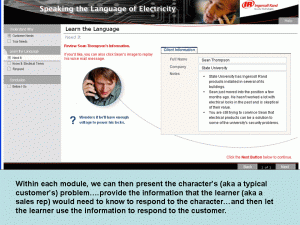Process makes perfect. Every organization needs some tried and true methods that they can rely on in the trenches. I want to share a method BLP often uses when working subject matter experts (SMEs) to create scenarios that drive many of our e-learning courses. After I review the process, I’ll share a finished example to help illustrate the end result of the process.
The 4-Step Process
We create “scenario worksheets” that we use with SMEs. We explain to our SMEs (who often initially resist the idea that we need stories to drive their content) that scenarios do several things: 1) Immediately engage the learner; 2) Give a contextual way to share content (i.e. a job context that mirrors’ learners own job contexts); 3) Set up a story that can be used to create interactivity by inspiring the learner to “solve” the character’s problems or challenges. 4) Keep the learner engaged throughout the learning.
Here are typical steps we use in creating scenarios and the questions we pose to SMEs, regardless of topic. We often create “scenario worksheets” that SMEs either fill in or respond to via interview based on this 4-step process. Note that the 4-steps are not completely linear. You may start with step 1, answer a few of the questions, move to Step 2, and find that new details related to the characters emerge as you go:
1) Define the character or characters in the story:
- What are their names?
- What do they look like? (age, gender, ethnicity, clothing, etc)
- What do they do? (We want to know their job title, employer, etc.)
- What information is critical to know about them? (i.e. are they new to the job, experienced, great performer, poor performer, unhappy customer, happy customer, etc.)
- What other background details will add authenticity to them and help paint a picture? (i.e. prior experience, significant events in their lives, personal information, etc.)
2) Determine the situation:
- What does the character need to accomplish? (Obviously the challenge relates to the course you are writing. If you are creating a sales training course, for example, your challenge might be the need to increase sales in a territory. If you are teaching statistical design of experiments, the challenge might be the need to determine the best temperature at which to mix an active ingredient.)
3) Describe common obstacles that the character needs to overcome. These obstacles should mirror ones that exist in the real workplace:
- Does the main character lack information? Expertise? Time? Money? People resources?
- Does the main character face obstacles in the form of people who are hindering progress or success? This could be an uninformed customer, an unhappy parent, a disgruntled fellow employee.
- Does the main character face obstacles in the form of situational barriers such as economic conditions, a compressed timeline, unexpected turns of events, etc?
4) Define the process that the main character goes through to resolve the challenge and manage/remove the obstacles: (We typically write the content for this one based on the content provided by SMEs. Typically, It’s what they want to “tell” learners. We turn the “tell” around to become more of “show me” and “let me try it” types of events.
- What new information will the main character discover to resolve the situation? How will the character discover this information? How will they use it to solve their problems?
- What new skills will the main character develop to resolve the situation? How will they acquire the skills?
- What resources will be available for the character to use as he or she resolves the challenges? Will we create job aids that the learner can use to help the main character? Will the main character access a virtual job aid?
An example
We completed a two-course series for a client a awhile back on basic electrical terminology and troubleshooting. The first course was designed to teach new sales reps basic electrical terminology. One method would have been to simply present all the terms reps need to know. However, this method isn’t very engaging or helpful to the learner. We opted, instead, to think about the “how” and the “when.” When would reps be likely to need an understanding of terminology? How would they typically be using the terminology? We crafted three scenarios for the course and then wove the stories throughout the course.
The entire course opened with 3 voice mails from the customers we created. Each subsequent module then focused on one of the scenarios. Learners started and ended each module with the scenario with the content required to resolve the scenario successfully sandwiched between. The course was hugely successful.
 We opened each module with a review of the scenario. Learners then gathered the info they needed to respond.
We opened each module with a review of the scenario. Learners then gathered the info they needed to respond.Other tips
If we are creating a curriculum as opposed to a single course, we set up an Excel spreadsheet that lists the characters we will use and key details about them. We also create image files for each character so we have a pool of images to use as we tell our story. These are both incredibly helpful organizational tools.





